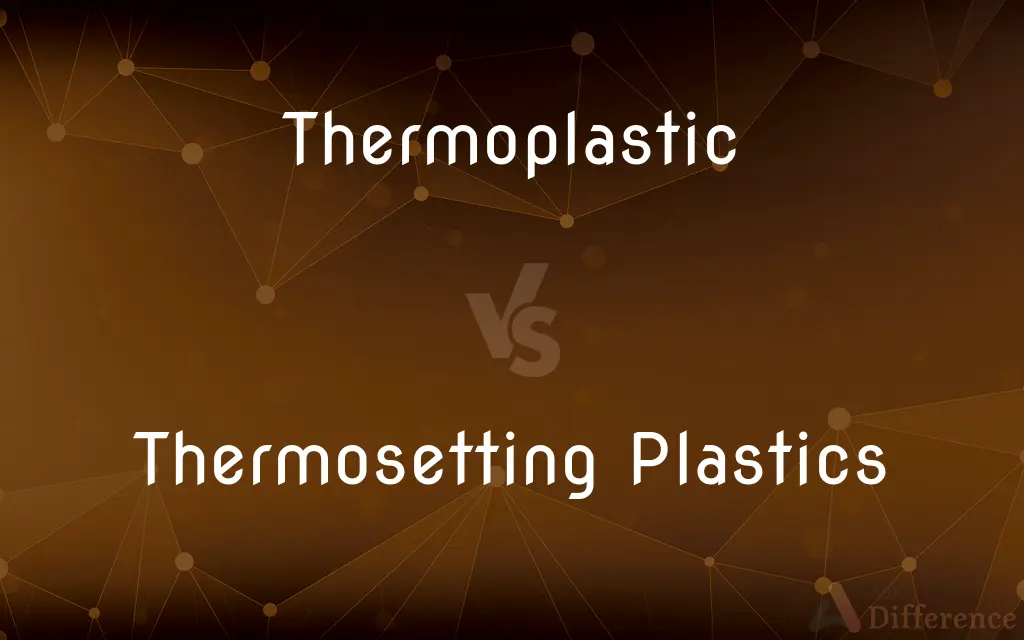Thermoplastic vs. Thermosetting Plastics — What's the Difference?
By Tayyaba Rehman — Published on January 2, 2024
Thermoplastics soften on heating and harden on cooling, repeatedly. Thermosetting plastics irreversibly set into a solid form when heated.

Difference Between Thermoplastic and Thermosetting Plastics
Table of Contents
ADVERTISEMENT
Key Differences
Thermoplastic materials are polymers that become pliable or moldable above a specific temperature and solidify upon cooling. They can be reheated and reshaped multiple times without significant chemical change. This characteristic allows thermoplastics to be recycled easily. On the contrary, thermosetting plastics are polymers that undergo a chemical change when heated, creating a three-dimensional network. After setting, they cannot be remolded or reheated to shape.
Thermoplastics are known for their versatility and are used in a variety of applications, from plastic bags to high-stress mechanical parts. The chains of polymers slide past one another when heat is applied, which accounts for their malleable nature. Thermosetting plastics, however, once cured, form a permanent bond that cannot be reshaped, making them ideal for high-heat applications like electrical insulation and auto parts.
In the realm of production and manufacturing, thermoplastics offer advantages due to their ability to undergo multiple cycles of heating and shaping. This feature is absent in thermosetting plastics, as they are designed to become insoluble and infusible after the initial forming process. The thermosetting process creates materials that are generally stronger and more durable than thermoplastics, but lack the latter's reusability.
The market for thermoplastics is significantly larger due to their recyclability and ease of use in manufacturing processes like injection molding and extrusion. Meanwhile, thermosetting plastics, though less versatile in terms of remolding, are indispensable in applications requiring materials that can withstand high temperatures and resist deformation under load.
Chemically, thermoplastics consist of long polymer chains with no significant cross-linking, which contributes to their ability to soften. Thermosetting plastics, conversely, are heavily cross-linked, providing a tight network of bonds that give them their strength and thermal stability. This fundamental chemical difference defines their distinct physical properties and areas of application.
ADVERTISEMENT
Comparison Chart
Reusability
Can be reheated and reshaped.
Cannot be reshaped once set.
Chemical Structure
Linear or slightly branched long chains.
Tightly cross-linked, three-dimensional networks.
Heat Resistance
Soften with heat, may deform under high temperature
Retain form at high temperatures, high heat resistance
Production Process
Suitable for injection molding and extrusion.
Suited for compression molding, not extrudable.
Recycling
Recyclable.
Not recyclable, cannot be remelted.
Compare with Definitions
Thermoplastic
Thermoplastics harden upon cooling and can repeat this process
After cooling, the thermoplastic part was as good as new.
Thermosetting Plastics
Thermosetting plastics cannot be softened once set
This thermosetting plastic component will withstand the engine’s heat.
Thermoplastic
Thermoplastics are polymers that melt when heated
We used a thermoplastic to create the prototype.
Thermosetting Plastics
Thermosetting plastics have a tightly cross-linked polymer structure
The thermosetting plastics used in this circuit board prevent melting.
Thermoplastic
Thermoplastics are recyclable plastics
The thermoplastic bottles were ground into flakes for recycling.
Thermosetting Plastics
Thermosetting plastics provide excellent temperature and chemical resistance
We chose thermosetting plastics for the chemical tanks.
Thermoplastic
Thermoplastics become moldable at elevated temperatures
The thermoplastic was heated before being injected into the mold.
Thermosetting Plastics
Thermosetting plastics irreversibly solidify when heated
The thermosetting plastics formed the heat-resistant casing.
Thermoplastic
Thermoplastics allow for easy processing and reshaping
The manufacturer favored thermoplastic for its reworkability.
Thermosetting Plastics
Thermosetting plastics are infusible and insoluble
The thermosetting plastics in this appliance ensure its longevity.
Thermoplastic
Becoming soft when heated and hard when cooled.
Thermoplastic
A thermoplastic resin, such as polystyrene or polyethylene.
Thermoplastic
Softening when heated and hardening when cooled, and thus able to be moulded
Thermoplastic
A plastic with this property.
Thermoplastic
A material that softens when heated and hardens again when cooled
Thermoplastic
Having the property of softening or fusing when heated and of hardening and becoming rigid again when cooled;
Thermoplastic materials can be remelted and cooled time after time without undergoing any appreciable chemical change
Common Curiosities
Can thermosetting plastics be recycled?
Thermosetting plastics are not typically recyclable due to their cross-linked structure.
Are thermoplastic materials recyclable?
Yes, most thermoplastic materials are recyclable.
What happens when thermosetting plastics are reheated?
Thermosetting plastics cannot be melted again; they will decompose or burn if reheated.
What are some common uses for thermoplastic?
Thermoplastic is commonly used in packaging, containers, toys, and automotive parts.
Where are thermosetting plastics commonly used?
Thermosetting plastics are used in electronic components, adhesives, and appliance housings.
Do thermoplastics have a high melting point?
Thermoplastics have a wide range of melting points, but generally, they have lower melting points than thermosetting plastics.
Can thermoplastic be melted and reformed?
Yes, thermoplastic can be melted and reformed multiple times.
What is a major advantage of thermoplastics over thermosetting plastics?
A major advantage of thermoplastics is their ability to be remelted and reformed.
What processing methods are used for thermosetting plastics?
Thermosetting plastics are processed by compression molding, casting, or reaction injection molding.
Are thermosetting plastics strong?
Yes, thermosetting plastics are known for their strength and durability.
How are thermoplastic materials processed?
Thermoplastic materials are often processed by injection molding, extrusion, or thermoforming.
Is PVC a thermoplastic or thermosetting plastic?
PVC, or polyvinyl chloride, is a thermoplastic.
Is epoxy a thermoplastic or thermosetting plastic?
Epoxy is a thermosetting plastic.
Are thermoplastics suitable for outdoor applications?
Some thermoplastics are suitable for outdoor applications, especially if they have UV stabilizers added.
Can thermosetting plastics resist high temperatures?
Yes, thermosetting plastics can resist higher temperatures without losing their shape.
Share Your Discovery

Previous Comparison
Great Britain vs. United Kingdom
Next Comparison
Impact Printers vs. Non-Impact PrintersAuthor Spotlight
Written by
Tayyaba RehmanTayyaba Rehman is a distinguished writer, currently serving as a primary contributor to askdifference.com. As a researcher in semantics and etymology, Tayyaba's passion for the complexity of languages and their distinctions has found a perfect home on the platform. Tayyaba delves into the intricacies of language, distinguishing between commonly confused words and phrases, thereby providing clarity for readers worldwide.














































